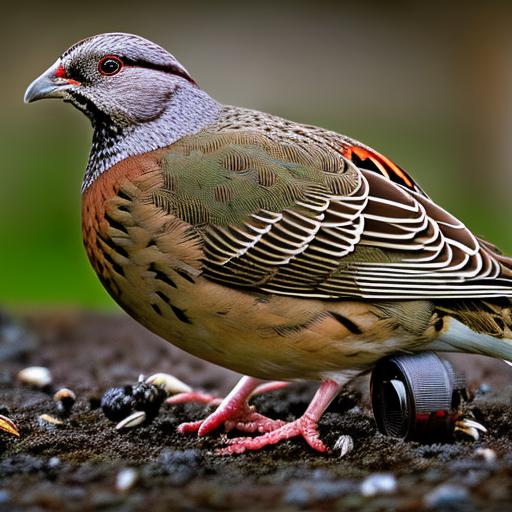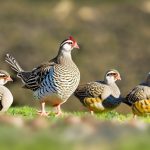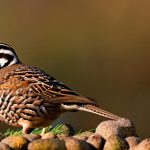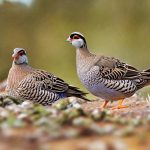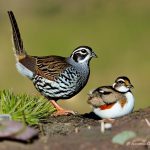Keeping quail and pigeons together can be a rewarding experience for poultry enthusiasts. Quail are small, ground-dwelling birds known for their delicious eggs and meat, while pigeons are larger, more social birds often kept for their beauty and homing abilities. When kept together, these two species can complement each other in terms of behavior, space utilization, and even pest control. However, it’s important to understand the specific needs of each species in order to create a harmonious living environment for both quail and pigeons.
Quail are known for their ability to thrive in small spaces, making them an ideal addition to a pigeon coop. They are also excellent foragers and can help keep the coop clean by eating insects and other pests. Pigeons, on the other hand, are social birds that thrive in flocks and require more space to fly and roost. By understanding the unique needs of both quail and pigeons, poultry keepers can create a coop environment that meets the needs of both species while promoting their health and well-being. In this article, we will explore the various aspects of keeping quail with pigeons, including housing and coop design, feeding and nutrition, health and disease management, behavior and social dynamics, and breeding and reproduction. By understanding these key areas, poultry keepers can successfully co-habit quail and pigeons in a way that benefits both species.
Key Takeaways
- Quail and pigeons can be kept together in the same coop, but it’s important to understand their specific needs and behaviors to ensure successful co-habitation.
- When designing a coop for quail and pigeons, it’s important to provide separate areas for nesting, roosting, and feeding to accommodate their different habits and preferences.
- Quail and pigeons have different dietary requirements, so it’s important to provide a balanced diet that meets the nutritional needs of both species.
- Regular health checks and disease management are essential for maintaining the well-being of quail and pigeons, as they can be susceptible to different illnesses and parasites.
- Understanding the social dynamics and behaviors of quail and pigeons is crucial for creating a harmonious environment, as they may have different hierarchies and communication styles.
- Breeding and reproduction of quail and pigeons require careful monitoring and management to ensure successful hatching and rearing of offspring.
- Successful co-habitation of quail and pigeons can be achieved by providing adequate space, meeting their specific needs, and closely monitoring their interactions and well-being.
Housing and Coop Design for Quail and Pigeons
When it comes to housing quail and pigeons together, it’s important to consider the specific needs of each species. Quail require a secure, ground-level enclosure with plenty of space to move around and forage. They also need protection from predators and the elements, as well as access to nesting areas for laying eggs. Pigeons, on the other hand, require a larger, elevated space with perches for roosting and plenty of room to fly and socialize. When designing a coop for both quail and pigeons, it’s important to create separate areas that meet the specific needs of each species while allowing for interaction between the two.
For quail, a simple wire mesh enclosure with a solid floor is ideal for protecting them from predators while allowing them to forage for insects and seeds. Providing nesting boxes or areas with straw or shavings will encourage quail to lay eggs in a safe and comfortable environment. Pigeons, on the other hand, require a larger coop with elevated perches, nesting boxes, and access to an outdoor flight area. The coop should be well-ventilated and provide protection from the elements while allowing for plenty of natural light. By creating separate areas within the coop that meet the specific needs of quail and pigeons, poultry keepers can ensure that both species have a comfortable and secure living environment.
Feeding and Nutrition for Quail and Pigeons
Feeding and nutrition are important aspects of keeping quail and pigeons healthy and thriving. Quail are omnivorous birds that require a diet high in protein, including seeds, insects, and commercial game bird feed. They also need access to grit or small stones to aid in digestion. Pigeons are granivorous birds that primarily eat seeds and grains, such as corn, wheat, and peas. They also require access to grit for digestion and calcium supplements for egg production.
When keeping quail and pigeons together, it’s important to provide separate feeding areas to prevent competition for food. Quail should have access to game bird feed and insects in a ground-level area, while pigeons should have access to seeds and grains in an elevated feeder. Additionally, providing access to fresh water at all times is essential for both quail and pigeons. By understanding the specific dietary needs of each species and providing separate feeding areas within the coop, poultry keepers can ensure that both quail and pigeons receive the nutrition they need to thrive.
Health and Disease Management for Quail and Pigeons
Maintaining the health of quail and pigeons is essential for successful co-habitation. Both species are susceptible to a variety of diseases and parasites that can impact their well-being. Common health issues for quail include respiratory infections, coccidiosis, and external parasites such as mites and lice. Pigeons are prone to respiratory infections, canker, and parasites such as lice and feather mites. To prevent the spread of disease between quail and pigeons, it’s important to practice good biosecurity measures, including regular cleaning and disinfection of the coop, as well as quarantine procedures for new birds.
In addition to good biosecurity practices, providing a clean living environment with proper ventilation is essential for preventing respiratory infections in both quail and pigeons. Regular health checks and observation of behavior can help poultry keepers identify potential health issues early on. By understanding the common health issues that affect quail and pigeons and implementing preventative measures, poultry keepers can promote the overall health and well-being of both species.
Behavior and Social Dynamics between Quail and Pigeons
Understanding the behavior and social dynamics of quail and pigeons is essential for creating a harmonious living environment within the coop. Quail are ground-dwelling birds that are known for their skittish nature and tendency to startle easily. They are also social birds that thrive in small flocks. Pigeons, on the other hand, are highly social birds that form strong pair bonds and live in larger flocks. By understanding the natural behaviors of both quail and pigeons, poultry keepers can create a coop environment that promotes their well-being.
When kept together, quail and pigeons may exhibit natural behaviors such as foraging, dust bathing, preening, and nesting. Providing plenty of space for these activities within the coop can help reduce stress and promote natural behaviors. Additionally, providing hiding spots or areas of dense vegetation can help quail feel secure within the coop environment. By understanding the behavior and social dynamics of quail and pigeons, poultry keepers can create a coop environment that meets the natural needs of both species while promoting their overall well-being.
Breeding and Reproduction of Quail and Pigeons
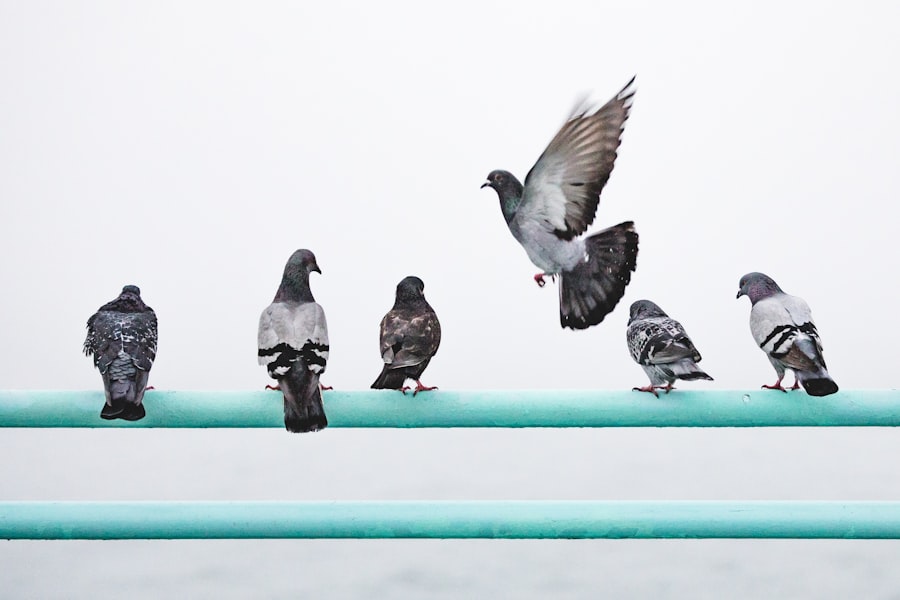
Breeding and reproduction are natural behaviors for both quail and pigeons that poultry keepers may want to encourage within their coop environment. Quail are prolific layers that can produce large numbers of eggs throughout the breeding season. Providing nesting areas with straw or shavings can encourage quail to lay eggs in a safe and comfortable environment. Pigeons are also prolific breeders that form strong pair bonds and raise their young together. Providing nesting boxes or areas with nesting materials can encourage pigeons to breed within the coop environment.
When breeding quail and pigeons together, it’s important to provide separate nesting areas to prevent competition for space. Additionally, providing privacy for nesting birds can help reduce stress and promote successful breeding behaviors. By understanding the natural breeding behaviors of quail and pigeons and providing appropriate nesting areas within the coop environment, poultry keepers can encourage successful breeding and reproduction within their flock.
Conclusion and Tips for Successful Co-habitation of Quail and Pigeons
In conclusion, keeping quail with pigeons can be a rewarding experience for poultry enthusiasts when done thoughtfully. By understanding the specific needs of each species in terms of housing, feeding, health management, behavior, and breeding, poultry keepers can create a harmonious living environment that promotes the well-being of both quail and pigeons. Some tips for successful co-habitation of quail with pigeons include providing separate areas within the coop that meet the specific needs of each species, practicing good biosecurity measures to prevent disease spread, providing plenty of space for natural behaviors such as foraging and nesting, and encouraging successful breeding behaviors through appropriate nesting areas.
By following these tips and understanding the unique needs of both quail and pigeons, poultry keepers can create a coop environment that promotes the health, well-being, and natural behaviors of both species. With proper care and attention to their specific needs, quail and pigeons can thrive together in a shared living environment, providing poultry enthusiasts with the joy of raising two unique bird species side by side.
If you’re considering keeping quail with pigeons, it’s important to understand the compatibility and potential challenges of housing these birds together. Poultry Wizard offers a helpful article on “What Kind of Coop is Best for Chickens,” which provides valuable insights into creating a suitable living environment for different types of poultry. Understanding the specific needs of each bird species can help ensure their well-being and harmonious cohabitation. Check out the article here for expert advice on creating an ideal coop setup.
FAQs
What are the benefits of keeping quail with pigeons?
Keeping quail with pigeons can provide several benefits, such as pest control, as quail eat insects and pests that may be harmful to the pigeons. Additionally, quail can help keep the pigeon coop clean by eating leftover food and droppings.
What should be considered when keeping quail with pigeons?
When keeping quail with pigeons, it is important to consider the space requirements for both species, as well as their dietary needs. Additionally, it is important to monitor the interactions between the quail and pigeons to ensure they are getting along and not causing harm to each other.
What are the potential challenges of keeping quail with pigeons?
One potential challenge of keeping quail with pigeons is ensuring that both species have access to the appropriate food and water, as their dietary needs may differ. Additionally, it is important to monitor the health and behavior of both species to ensure they are not experiencing any negative effects from cohabitating.
Can quail and pigeons be housed together in the same coop?
Yes, quail and pigeons can be housed together in the same coop, as long as the coop is large enough to accommodate both species and their specific needs. It is important to provide separate areas for nesting and roosting to prevent any potential conflicts between the quail and pigeons.
What are some tips for successfully keeping quail with pigeons?
Some tips for successfully keeping quail with pigeons include providing ample space for both species, ensuring they have access to appropriate food and water, and monitoring their interactions to prevent any potential conflicts. Additionally, it is important to regularly clean the coop to maintain a healthy environment for both quail and pigeons.
Meet Walter, the feathered-friend fanatic of Florida! Nestled in the sunshine state, Walter struts through life with his feathered companions, clucking his way to happiness. With a coop that’s fancier than a five-star hotel, he’s the Don Juan of the chicken world. When he’s not teaching his hens to do the cha-cha, you’ll find him in a heated debate with his prized rooster, Sir Clucks-a-Lot. Walter’s poultry passion is no yolk; he’s the sunny-side-up guy you never knew you needed in your flock of friends!

